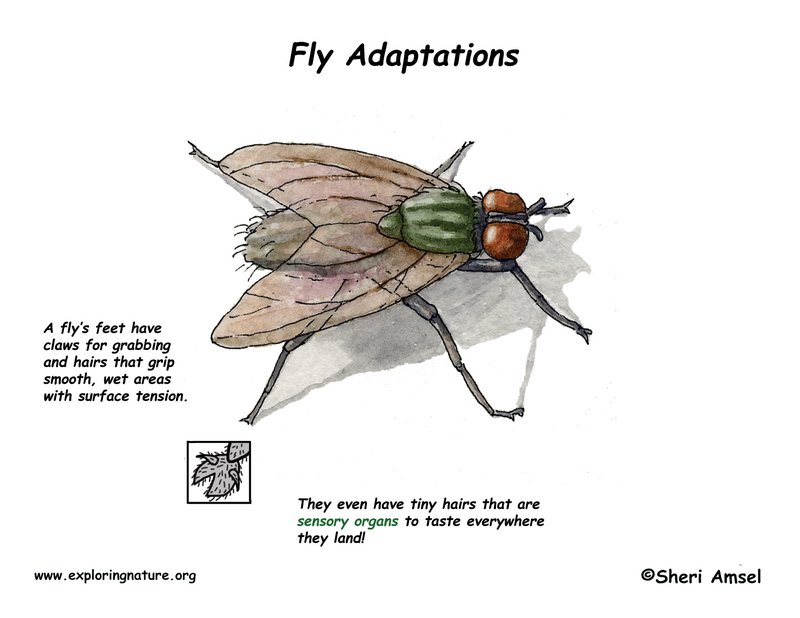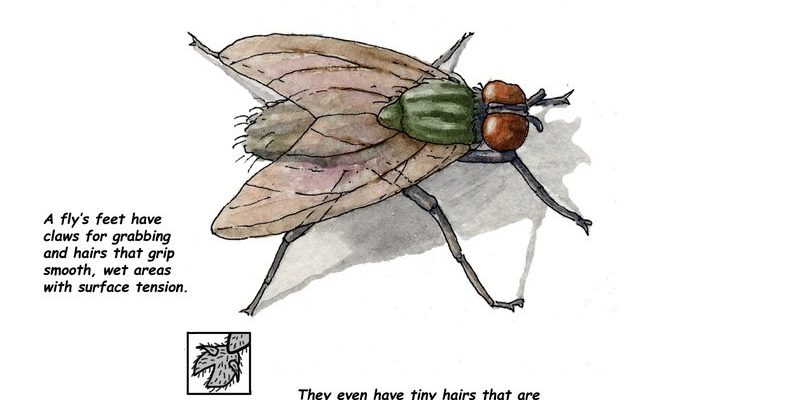
Just like a chameleon changes its colors to blend in with surroundings, flies have their own set of tricks to survive both in urban environments and natural settings. So, let’s dive deep into the world of flies, exploring where they live and how they’ve evolved to fit into almost every ecosystem you can think of.
The Many Habitats of Flies
Flies are born explorers—they thrive in a multitude of habitats. You can find them buzzing around in urban areas, rural farms, forests, and even mountains. It’s almost like they have an endless range of addresses!
1. Urban Environments: In the city, flies often make their homes in garbage heaps, compost piles, and dumpsters. These places might sound unappealing to us, but they offer a buffet of organic materials for flies. Think about it: all that food waste provides the nutrients they need to grow and reproduce. Plus, familiar urban settings often lack natural predators, allowing them to flourish.
2. Rural Areas and Farms: On the farm, flies play a crucial role in breaking down waste and can often be found around livestock. Horseflies and stable flies, for example, are not just nuisances; they help recycle nutrients back into the soil. Farmers sometimes tolerate flies because they help with this natural process, though it can be a balancing act with pest control.
3. Natural Habitats: In nature, flies are found in forests, wetlands, and grasslands. Here, they feed on decaying plant matter, nectar, and fruits. The diverse environments mean that different species of flies have specialized adaptations. Some thrive in moist areas, while others prefer dryer climates.
4. Adaptation to Extreme Conditions: Believe it or not, some species of flies can live in extreme environments, such as the Arctic or the deserts. Arctic flies have adapted to cold temperatures by developing antifreeze-like substances in their bodies. Desert flies have evolved to go long periods without water, employing tricks like burrowing into the sand during the hottest parts of the day to avoid dehydration.
How Flies Adapt to Their Environment
Flies are not just survivors; they’re skilled at adapting to their surroundings, which is one of the reasons they thrive in so many different habitats. Their adaptability can be broken down into several key strategies.
1. Physical Adaptations: One of the most fascinating aspects of flies is their physical adaptability. For example, houseflies have specialized mouthparts that allow them to feed on a variety of substances, from sugary drinks to rotting food. This flexibility in diet means they can survive in more places than creatures with stricter dietary preferences.
2. Behavioral Adaptations: Flies exhibit interesting behavior when it comes to avoiding predators. They often use quick, erratic flight patterns to evade birds and other threats. For instance, the common housefly can change direction abruptly, making it harder for predators to catch them. It’s like they’re dancing through the air, always out of reach!
3. Reproductive Strategies: Flies also adapt their reproductive strategies based on their environment. Some species produce fewer eggs but take great care of them, while others lay hundreds of eggs in a short time. This variance means that flies can increase their chances of survival depending on their habitat conditions. In nutrient-rich environments, it makes sense to reproduce quickly, while in harsher conditions, quality over quantity might be key.
4. Resistance to Pesticides: Unfortunately for us, some flies have developed a resistance to common pesticides. This adaptation allows them to thrive even in environments where they’re targeted for extermination. The more they’re exposed to certain chemicals, the more likely they are to change, leading to generations of flies that can survive human efforts to control their populations.
The Diet of Flies: What They Eat and Why It Matters
You might wonder what exactly flies eat and how that ties into their adaptability. The truth is, flies have a surprisingly diverse diet, which allows them to thrive in various habitats.
1. Decaying Organic Matter: Many flies, like the common fruit fly, thrive on decomposing fruit and vegetables. This diet helps break down organic materials, contributing to nutrient cycling in ecosystems. Their role in breaking down waste is essential for the health of the environment.
2. Nectar and Plant Materials: Some species, such as hoverflies, primarily feed on nectar. This makes them important pollinators, even if they’re often overshadowed by bees. While they may appear unassuming, their contribution to pollination is significant, affecting everything from flowers to the fruits we enjoy.
3. Meat and Other Proteins: Certain flies, like the infamous blowfly, are attracted to decaying meat. They often lay their eggs on carcasses, allowing their larvae to feed on the protein-rich resource. This behavior assists in decomposition, making room for new life in ecosystems.
4. Fungi and Yeasts: Interestingly, some flies, especially those in tropical regions, have been found to feed on fungi and yeasts. These unique dietary habits allow them to utilize resources that many other insects can’t, showcasing their ability to adapt to various ecological niches.
The Life Cycle of Flies
Understanding the life cycle of flies sheds light on how they adapt and thrive in different habitats. Their life cycle can be broken down into four stages: egg, larva, pupa, and adult.
1. Egg Stage: The adult female fly lays hundreds of eggs, often in a suitable environment rich in food sources. This stage is crucial for survival, as it sets the foundation for the next generations. The rapid reproduction rate is a strategy for ensuring that some survive even in challenging conditions.
2. Larval Stage: After hatching, the larvae (or maggots) begin to feed on the organic matter where they were laid. This stage is all about growth and development. They quickly consume nutrients, which helps them grow and prepare for the next stage. The faster they grow, the sooner they can become adults.
3. Pupal Stage: Once the larvae have grown sufficiently, they enter the pupal stage, where they undergo transformation. During this time, the maggot changes into an adult fly. This stage of development allows them to emerge as fully formed adults ready to mate and reproduce.
4. Adult Stage: Finally, the adult fly emerges and begins its life in the world. During this stage, flies can live anywhere from a few weeks to several months, depending on environmental conditions and species. Their brief lives can be filled with frequent reproduction, ensuring that their species continues.
How Flies Impact Their Ecosystems
While flies might seem like mere annoyances, they play a vital role in the ecosystem. Their presence affects various biological processes and contributes to the overall health of environments.
1. Decomposers: Flies are essential decomposers. By feeding on decaying organic matter, they help break it down and recycle nutrients back into the soil. This process supports plant growth, creating a healthier ecosystem overall.
2. Pollinators: Various species of flies also act as pollinators. While bees grab most of the attention, hoverflies and others contribute significantly to pollination. Their activities ensure that plants can reproduce, which is vital for food production and maintaining biodiversity.
3. Food Source: Flies provide food for numerous predators, including birds, bats, and certain insects. In this way, they are an integral part of the food web, contributing to the balance of various ecosystems.
4. Indicator Species: The presence or absence of flies can indicate the health of an environment. For example, a high population of flies may indicate a surplus of organic waste, while their absence could signal environmental changes that impact biodiversity.
Common Misconceptions About Flies
Despite their essential roles, flies are often misunderstood. Let’s clarify a few common misconceptions.
1. Flies Are Just Pests: While they can be annoying, flies are not just nuisances. They are important components of ecosystems, contributing to decomposition and pollination. Recognizing their role can help foster a more respectful view of these creatures.
2. All Flies Are Dirty: Many people assume that all flies breed in dirty conditions. However, some species prefer cleaner environments. For instance, certain hoverflies can be found in gardens, where they help pollinate flowers without contributing to any hygiene issues.
3. Flies Have No Purpose: Some believe flies exist solely to annoy us. However, their roles as decomposers and pollinators mean they are essential for maintaining healthy ecosystems. Without them, our environment would struggle to function properly.
4. Flies Live Only a Few Days: While it’s true that some flies have short lifespans, many live longer, especially under favorable conditions. It’s crucial to recognize that their life cycle allows for rapid reproduction, making them seem more prevalent than they are.
In conclusion, flies are far more than pesky intruders. They occupy a wide range of habitats, showcasing incredible adaptability that allows them to thrive almost anywhere. By understanding where flies live and how they adapt, we gain a better appreciation for these tiny creatures and their crucial roles in our ecosystems. So next time you swat at a fly, consider this: they’re not just buzzing around aimlessly; they’re living their lives in a world where their adaptability is truly remarkable.

